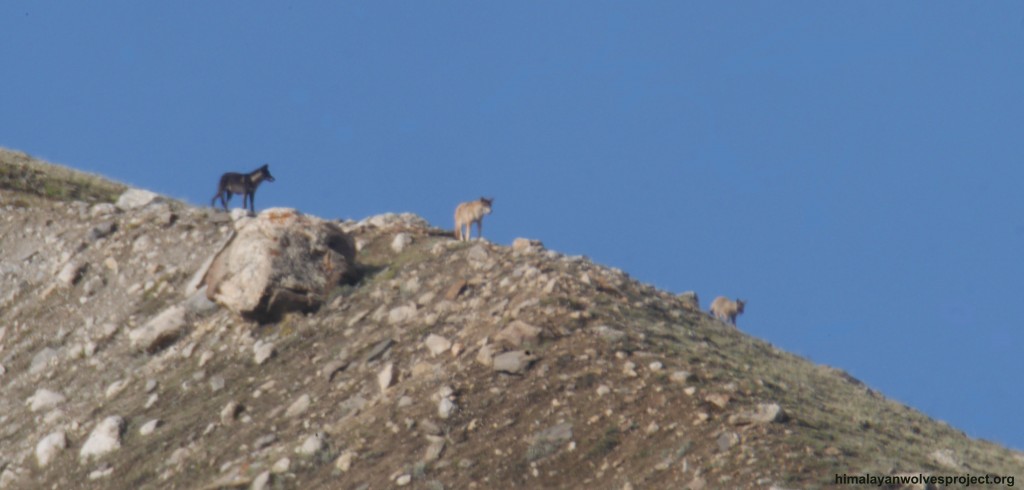Wolf Research Expedition to Humla in Nepal 2014
This research expedition collected field evidence of the wolves in the trans-Himalayas of western Nepal indicating that they belong to the genetic lineage of Himalayan wolves. Our study area in the rolling landscapes of the Tibetan Plateau in Humla on 5000m above sea level is home to a specialized high-altitude mammal community and contains a diverse flora. The area does not contain permanent human settlements due to the harsh climatic conditions but receives nomadic herders in the summer month. During this expedition we collected the ecological and genetic baseline data on these wolves and identified major conservation threats for the wolves and their prey through social surveys with local people. These scientific achievements are in line with the IUCN recommendations for the research and conservation of the wolf populations in the Himalayas.
Wolves and their prey
Wolves were frequently observed solely or in pairs traversing the alpine grasslands. In one specific encounter the team was woken up in the morning through wolf howls and discovered a pack of six wolves consisting of two adults and four pups climbing the opposite hill slope (video “Wolf pack in the Himalayas”). Regarding the prey availabiltiy for these wolves, we found that kiang Equus kiang are the most abundant ungulates roaming the landscape in large herds. They were followed in numbers by domestic yak Bos grunniens and domestic horse Equus ferus caballus, which strayed the area mainly unguarded.

Wolf pack Canis sp. in Ngin valley with three black and one grey pup, while the mother is black and the father grey!
Red foxes, Tibetan foxes and a unexpected wild yaks!
In the summer month marmots were found in large numbers and seem a good food source for the wolves during this season. Besides the wolves, two other canids were documented, red fox Vulpes vulpes and Tibetan fox V. ferrilata. Wolves were active over all times of the day with least activity during mid-day hours. Red foxes were strictly nocturnal, while Tibetan foxes were diurnal which is suspected to be linked to the activity of their main prey species, the Plateau pika Ochotona curzoniae. Our study verified the presence of low numbers of Tibetan gazelle Procapra picticaudata and argali Ovis ammon (both IUCN red listed as ‘Near Threatened’). And we rediscovered the wild yak Bos mutus in Nepal (IUCN red listed as ‘Vulnerable’), of which only fossils had indicated a historical presence of the species in Nepal.

Tibetan gazelle Procapra picticaudata roam upper Humla in small numbers and migrate to and from the Tibetan Autonomous Region across the border in China.
Talking with the local herders reveals the wildlife conflicts
Social surveys with local residents found livestock depredation in the pasture lands (including our study area) to be the major source of conflicts with wolves. However, most conflicts they seem to experience with snow leopards Panthera uncia followed by conflicts with wolves. The locals favoured solutions such as to improve husbandry techniques through the use of better tools. Buddhism favours wildlife protection and local religious leaders are prompting their followers not to kill wild animals. Wildlife, including wolves, is considered valuable by the local people and the majority wants it to be protected. However, illegal hunting and trade is a major conservation threat to many wildlife species in these regions, including wolves, as many species are used in the traditional Chinese medicine (TCM).

A grandfather with his grandchild in Halji village in Limi valley, Nepal. They belong to the ethnic group of Lama, which share Buddhist culture and speak the Tibetan language.
In summary, on this expedition we collected first indications for the presence of the poorly studied Himalayan wolves in the remote north-western area of Nepal and collected first data on its ecology and conservation. This knowledge about the wolves within their ecosystem builds the basis for more in-depth research and conservation implementations.




